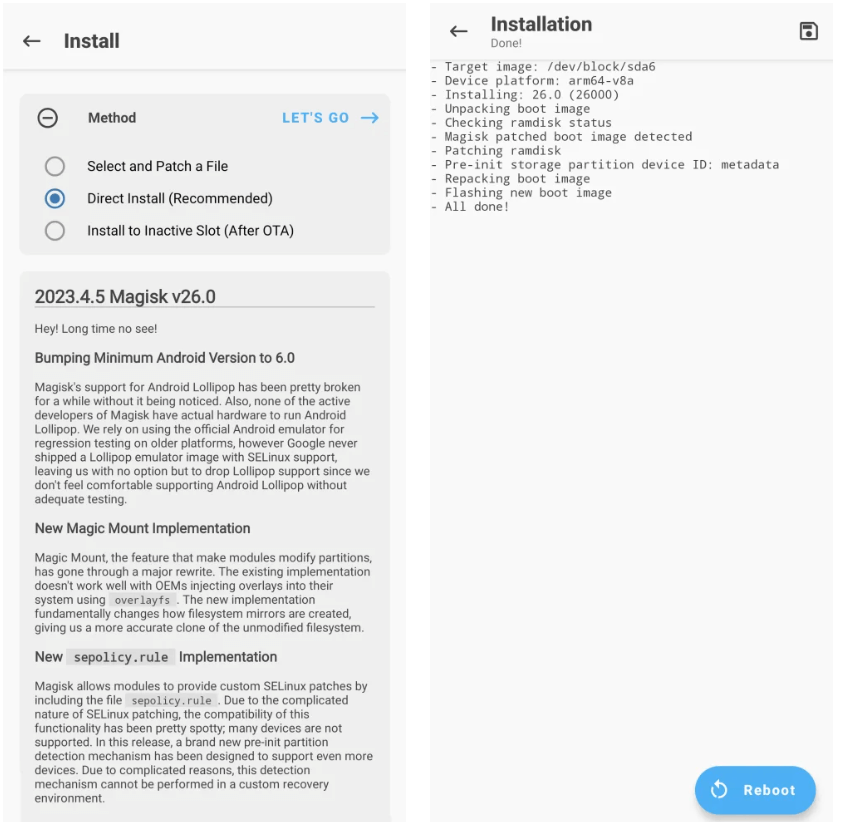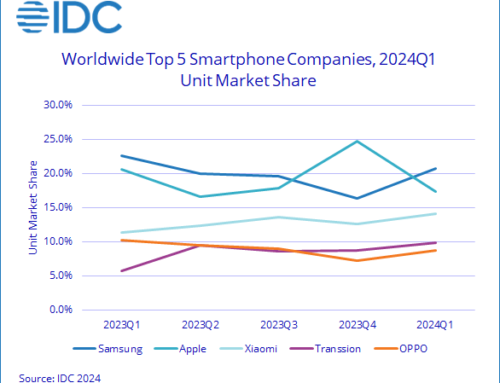- [App] Fix crashing when revoking root permissions
- [MagiskInit] Always prefer ext4 partitions over f2fs when selecting the pre-init partition
- [General] Restore module files’ context/owner/group from mirror. This is a regression introduced in v26.0
Good news for anyone that has their smartphones rooted using it, because Magisk v26 was released on April 5th, 2023, almost 1 year after the previous release (v25.2).
So what’s new in Magisk v26?
Increasing the minimum Android version to 6.0: Magisk will no longer support Android Lollipop due to the lack of adequate testing, as none of the active developers have the necessary hardware. The existing testing is performed using the official Android emulator, which does not have SELinux support. Therefore, to ensure better compatibility and performance, the minimum Android version for Magisk has been bumped to 6.0.
New Magic Mount implementation: The Magic Mount feature, which enables modules to modify partitions, has undergone a significant overhaul. The previous implementation did not work well with OEMs injecting overlays into their systems using overlayfs. The new implementation fundamentally changes how filesystem mirrors are created, resulting in a more precise clone of the unmodified filesystem.
New sepolicy.rule implementation: Magisk allows modules to provide custom SELinux patches through sepolicy.rule. However, due to the complexity of SELinux patching, the compatibility of this feature has been inconsistent across various devices. In this release, a new pre-init partition detection mechanism has been developed to support even more devices. Unfortunately, this detection mechanism cannot be performed in a custom recovery environment, meaning that an installation of Magisk v26+ using custom recovery will be incomplete and require a subsequent re-installation through the Magisk app after booting up.
Zygisk updates: Zygisk API v4 has been released, introducing new features and a refined PLT function hook API. The implementation of Zygisk has undergone significant refactoring, including new code loading/unloading mechanisms and a new PLT function hook implementation.
Other minor changes:
- [MagiskBoot] Support amonet microloader devices
- [MagiskBoot] Always use lz4_legacy compression on v4 boot images. This fixes boot image patching issues on Android U preview.
- [MagiskInit] Support replacing existing *.rc files in overlay.d
- [App] Make stub patching 100% offline
- [App] Support patching init_boot.img for Samsung ODIN firmware
- [MagiskPolicy] Fix minor bug in command line argument parsing
- [MagiskPolicy] Update rules to support Android U
If you already have Magisk installed it’s very easy to update, just use the Direct Install option available via its interface:
However, if you don’t have it installed, you can download the new version on Github: Magisk v26 download (apk)
What is Magisk?
If you don’t know what Magisk is, continue reading.
Magisk is a popular rooting solution for Android devices that allows users to gain root access to their device’s operating system while also bypassing Google’s SafetyNet security check.
Magisk works by modifying the boot image of the device, which is loaded when the device starts up. This modification allows Magisk to gain root access while also hiding this fact from the operating system and any apps that may be looking for root access. Additionally, Magisk provides a systemless interface for modules, which are essentially add-ons that can modify various aspects of the operating system, such as the device’s appearance, performance, or functionality.
Here are some of the main features of Magisk:
- System-less root: Magisk uses a system-less approach to rooting, which means it modifies the boot partition instead of the system partition. This makes it easier to pass Google’s SafetyNet checks and hide root access from apps that may not work on rooted devices.
- Magisk modules: Magisk allows users to install Magisk modules, which are essentially add-ons that can modify various aspects of the operating system. Users can easily install and uninstall modules using the Magisk Manager app.
- MagiskHide: MagiskHide is a feature that allows users to hide root access from specific apps, which can be useful for apps that may not work on rooted devices or for users who want to maintain the security of their device.
- Customization: Magisk offers a range of customization options, including the ability to modify the device’s boot animation, fonts, and status bar icons.
- Compatibility: Magisk is compatible with a wide range of devices and Android versions, making it a versatile rooting solution for Android users.
- SafetyNet checks: Magisk offers built-in support for Google’s SafetyNet checks, which allows users to use apps that may not work on rooted devices.
- OTA updates: Magisk allows users to install OTA (over-the-air) updates without losing root access or other customizations.
Overall, Magisk offers a range of features that make it a powerful and versatile rooting solution for Android users. Its system-less approach to rooting, support for Magisk modules, and compatibility with a wide range of devices and Android versions make it a popular choice among Android enthusiasts looking to customize their devices.
If you’re interested in rooting your Android device, here’s a video tutorial on how to Root Android Using MAGISK v26.0 & Custom Recovery
You can read more about it on their official Github page: https://github.com/topjohnwu/Magisk/





